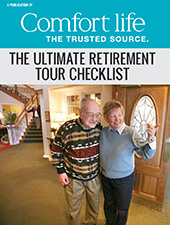What to know about this topic:
- Distinguishing features of life lease retirement homes
- Quick facts about life lease retirement communities
Life lease retirement homes offer mature adults - who are neither tenants nor owners – a stake in a community designed as a rewarding, supportive and affordable place to live.
Distinguishing features of life lease retirement homes
- Residents buy a life lease or leasehold interest in their accommodations, giving them a right to occupy the unit and use all the communal amenities, such as dining rooms, games rooms and lounges (some developments specify the term of occupancy based on the resident's lifetime, some have fixed terms such as 20 or 50 years, and some have no specified termination date)
- The majority of life lease communities are developed and owned by non-profit organizations, charitable groups, service clubs or religious institutions
- When a resident leaves or passes away, the lease usually can be sold to someone on the sponsor's waiting list or on the open market, or transferred back to the development's sponsoring organization. Some life lease agreements permit the interest to be passed to the resident's family through their will. The estate can then decide whether to sell this interest or retain it for their retirement.
- Most Ontario projects operate under a "market value" life lease model that means the seller will earn equity when they transfer their interest, similar to selling a private home
- Other life lease models, such as fixed value or declining value, vary depending on the terms of the initial lump-sum payment and the resident's entitlement to the increased equity at the end of the lease; lower initial purchase costs sometimes linked with a lower percentage share of the equity when lease is transferred or sold
- Sponsoring organization typically applies a percentage administration fee on sale and transfers, typically ranging from three to 10 per cent
- Communities may cater to a particular culture or religion
- Generally reserved for people at least 55 or older, however, those project attached to a care facility usually stipulate an age restriction of 65 plus
- Accommodation is typically apartments or townhouses
- Monthly maintenance fee usually applies to cover the operating costs of the life lease development
- Residents are often involved in both the building and lifestyle design, as well as the operation of the project and the social and recreational programs
Positives of a life lease community
- Supportive environment, low maintenance and security, companionship of other seniors
- Allows for a stake in a community, without many of the responsibilities of ownership or the insecurity of tenancy in rental accommodation
- Although designed for independent living, some offer a variety of support services like laundry, light housekeeping, meals and some medical assistance
- Generally more affordable than the traditional market
- Buyers pay for construction of the specific unit they have chosen to occupy and a portion of the common amenities, but units are usually offered for a break-even cost or below market value
- Residents often allowed input into the design of their unit and can request modifications to suit their personal needs and taste
- Market value life leases can offer the opportunity to increase equity value, similar to typical ownership
- If you leave, your unit usually can be sold on the open market or to someone on the sponsor's waiting list, or transferred back to the development sponsor
Quick facts about life lease retirement communities
- First Canadian life lease communities were in Saskatchewan and Manitoba
- About 70 projects in Ontario, with another 20 to 25 currently under development; about 200 altogether across Canada (as of the time of this writing)
- 80 per cent of life lease communities in Ontario sponsored by non-profit or charitable groups; another 10 per cent are joint ventures between charitable groups and private developers
- Owner/occupant residents purchasing life lease units sponsored by non-profit or charitable organizations in Ontario are exempt from land transfer taxes, saving an average buyer about 1.5 per cent of the purchase price of their unit
- Many developments linked or affiliated with retirement or long-term care communities
- Some market value life lease communities in Ontario have seen a capital appreciation as high as 20 per cent over a few years.
Some trends in life-lease
- Ontario has conducted researc/h on legislation to regulate life lease communities, including consumer protection laws
- Non-profits continue to embrace these projects as a viable way to develop affordable housing for seniors, without relying on government funding
- More private developers are taking an interest in the life lease concept
by Maureen Murray



